DESCRIPTION The A/F sensor
generates a voltage* that corresponds to the actual air-fuel ratio. This
sensor voltage is used to provide the ECM with feedback so that it can
control the air-fuel ratio. The ECM determines the deviation from the
stoichiometric air-fuel ratio, and regulates the fuel injection time. If
the A/F sensor malfunctions, the ECM is unable to control the air-fuel
ratio accurately. The A/F sensor is the planar
type and is integrated with the heater, which heats the solid
electrolyte (zirconia element). This heater is controlled by the ECM.
When the intake air volume is low (the exhaust gas temperature is low), a
current flows into the heater to heat the sensor in order to facilitate
accurate air-fuel ratio detection. In addition, the sensor and heater
portions are the narrow type. The heat generated by the heater is
conducted to the solid electrolyte through the alumina, and therefore
the sensor activation is accelerated. In order
to obtain a high purification rate of the carbon monoxide (CO),
hydrocarbon (HC) and nitrogen oxide (NOx) components in the exhaust gas,
a TWC is used. For the most efficient use of the TWC, the air-fuel
ratio must be precisely controlled so that it is always close to the
stoichiometric level. *: Value changes inside
the ECM. Since the A/F sensor is a current output element, a current is
converted into a voltage inside the ECM. Any measurements taken at the
A/F sensor or ECM connectors will show a constant voltage.
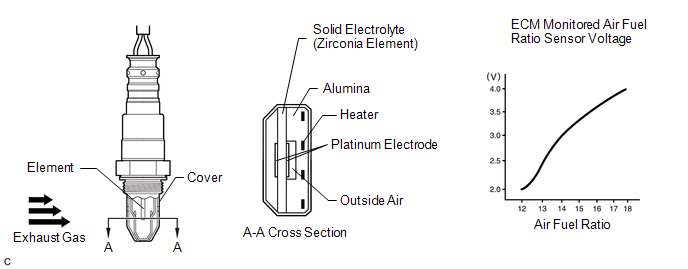 |
DTC No. | DTC Detection Condition |
Trouble Area | |
P2195 P2197 | Conditions (a) and (b) continue for 5 seconds or more
(2 trip detection logic): (a) A/F sensor voltage more than 3.8 V
(b) Heated oxygen (HO2) sensor voltage is 0.21 V or higher |
- Open or short in A/F sensor (for Sensor 1) circuit
- A/F sensor (for Sensor 1)
- A/F sensor heater (for Sensor 1)
- Integration relay
- A/F sensor heater and integration relay circuits
- Intake system
- Fuel pressure
- Fuel injector assembly
- EGR valve assembly
- ECM
| | While
fuel-cut operation performed (during vehicle deceleration), A/F sensor
current 2.2 mA or more for 3 seconds (2 trip detection logic) |
- A/F sensor
- EGR valve assembly
- ECM
| |
P2196 P2198 | Conditions (a) and (b) continue for 5 seconds or more
(2 trip detection logic): (a) A/F sensor voltage less than 2.8 V
(b) HO2 sensor voltage is below 0.66 V |
- Open or short in A/F sensor (for Sensor 1) circuit
- A/F sensor (for Sensor 1)
- A/F sensor heater (for Sensor 1)
- Integration relay
- A/F sensor heater and integration relay circuits
- Intake system
- Fuel pressure
- Fuel injector assembly
- EGR valve assembly
- ECM
| | While
fuel-cut operation performed (during vehicle deceleration), A/F sensor
current less than 0.7 mA for 3 seconds (2 trip detection logic) |
- A/F sensor
- EGR valve assembly
- ECM
|
HINT:
- DTCs P2195 and P2196 indicate malfunctions related to the bank 1 A/F sensor circuit.
- DTCs P2197 and P2198 indicate malfunctions related to the bank 2 A/F sensor circuit.
- When any of these DTCs is stored, check the A/F sensor output voltage by
entering the following menus: Powertrain / Engine and ECT / Data List /
AFS Voltage B1S1 or AFS Voltage B2S1.
- Short-term fuel trim values can also be read using the Techstream.
- The ECM regulates the voltages at the A1A+ and A1A- or A2A+ and A2A-
terminals of the ECM to a constant level. Therefore, the A/F sensor
output voltage cannot be confirmed without using the Techstream.
- If the A/F sensor is malfunctioning, the ECM stores DTC P2195, P2196, P2197 or P2198.
MONITOR DESCRIPTION Sensor voltage detection monitor
Under
the air-fuel ratio feedback control, if the A/F sensor output voltage
indicates rich or lean for a certain period of time, the ECM determines
that there is a malfunction in the A/F sensor. The ECM illuminates the
MIL and stores a DTC. Example: If
the A/F sensor output voltage is less than 2.8 V (very rich condition)
for 5 seconds, despite the rear HO2 sensor output voltage being less
than 0.66 V, the ECM stores DTC P2196 or P2198. Alternatively, if the
A/F sensor output voltage is more than 3.8 V (very lean condition) for 5
seconds despite the rear HO2 sensor output voltage being 0.21 V or
more, DTC P2195 or P2197 is stored. Sensor current detection monitor
A
rich air-fuel mixture causes a low A/F sensor current, and a lean
air-fuel mixture causes a high A/F sensor current. Therefore, the sensor
output becomes low during acceleration, and it becomes high during
deceleration with the throttle valve fully closed. The ECM monitors the
A/F sensor current during fuel-cut and detects any abnormal current
values. If the A/F sensor output is 2.2 mA or more
for more than 3 seconds of cumulative time, the ECM interprets this as a
malfunction in the A/F sensor and stores DTC P2195 or P2197 (high-side
stuck). If the A/F sensor output is less than 0.7 mA for more than 3
seconds of cumulative time, the ECM stores DTC P2196 or P2198 (low-side
stuck). 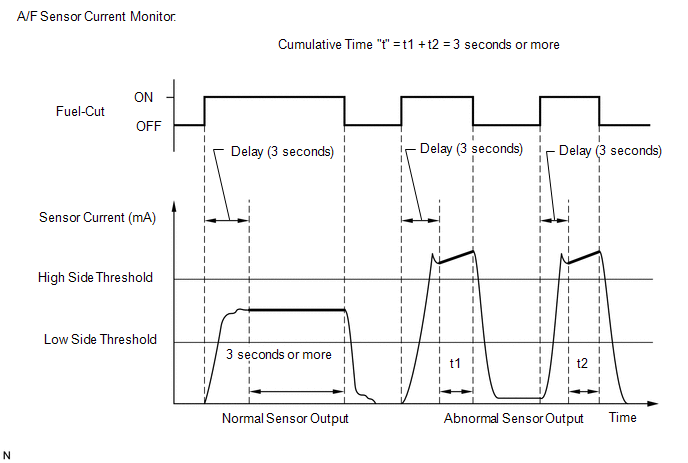 MONITOR STRATEGY |
Related DTCs | P2195: A/F sensor signal stuck lean (Bank 1)
P2196: A/F sensor signal stuck rich (Bank 1) P2197: A/F sensor signal stuck lean (Bank 2)
P2198: A/F sensor signal stuck rich (Bank 2) | |
Required Sensors/Components (Main) | A/F sensor | |
Required Sensors/Components (Related) |
HO2 sensor | | Frequency of Operation |
Continuous: Sensor voltage detection monitor Once per driving cycle: Sensor current detection monitor | |
Duration | 5 seconds: Sensor voltage detection monitor
3 seconds: Sensor current detection monitor | |
MIL Operation | 2 driving cycles | |
Sequence of Operation | None | TYPICAL ENABLING CONDITIONS All |
Monitor runs whenever following DTCs not present | P0016, P0018 (VVT system - Misalignment)
P0017, P0019 (Exhaust VVT system - Misalignment) P0031, P0032, P0051, P0052, P101D, P103D (Air fuel ratio sensor heater)
P006A, P0107, P0108 (Manifold absolute pressure) P0102, P0103 (Mass air flow meter)
P0112, P0113 (Intake air temperature sensor) P0115, P0117, P0118 (Engine coolant temperature sensor)
P0120, P0121, P0122, P0123, P0220, P0222, P0223, P2135 (Throttle position sensor)
P0125 (Insufficient Coolant Temperature for Closed Loop Fuel Control)
P0128 (Thermostat) P0171, P0172, P0174, P0175 (Fuel system)
P0301 - P0308 (Misfire) P0335 (Crankshaft position sensor) P1340 (Camshaft position sensor)
P0401 (EGR system) P0412, P0415, P0418, P0419, P1613, P1614 (Secondary Air Injection System Control)
P0451, P0452, P0453 (Evaporative Emission System Pressure Sensor) P0500 (Vehicle speed sensor)
P0505 (IAC valve) P219A, P219B, P219C, P219D, P219E, P219F, P21A0, P21A1, P21A2, P21A3 (Air-fuel ratio imbalance)
P2440, P2441, P2442, P2443, P2444, P2445, P2446, P2447 (Secondary Air Injection System) | Sensor Voltage Detection Monitor |
Time after engine start | 30 seconds or more | |
A/F sensor status | Activated | |
Fuel system status | Closed-loop | Sensor Current Detection Monitor |
Battery voltage | 11 V or more | |
Atmospheric pressure | 76 kPa (570 mmHg) or more | |
A/F sensor status | Activated | |
Continuous time of fuel cut | 3 to 10 seconds | |
ECT | 75°C (167°F) or more | TYPICAL MALFUNCTION THRESHOLDS Sensor Voltage Detection Monitor (Lean Side Malfunction P2195 and P2197) |
Rear HO2S voltage | 0.21 V or higher | |
A/F sensor voltage | More than 3.8 V | Sensor Voltage Detection Monitor (Rich Side Malfunction P2196 and P2198) |
Rear HO2S voltage | Below 0.66 V | |
A/F sensor voltage | Below 2.8 V | Sensor Current Detection Monitor (High Side Malfunction P2195 and P2197) |
Duration of following condition | 3 seconds or more | |
A/F sensor current | 2.2 mA or more | Sensor Current Detection Monitor (Rich Side Malfunction P2196 and P2198) |
Duration of following condition | 3 seconds or more | |
A/F sensor current | Less than 0.7 mA | MONITOR RESULT
Refer to Checking Monitor Status (See page  ). ). CONFIRMATION DRIVING PATTERN
This
confirmation driving pattern is used in the "PERFORM CONFIRMATION
DRIVING PATTERN" procedure of the following diagnostic troubleshooting
procedure. 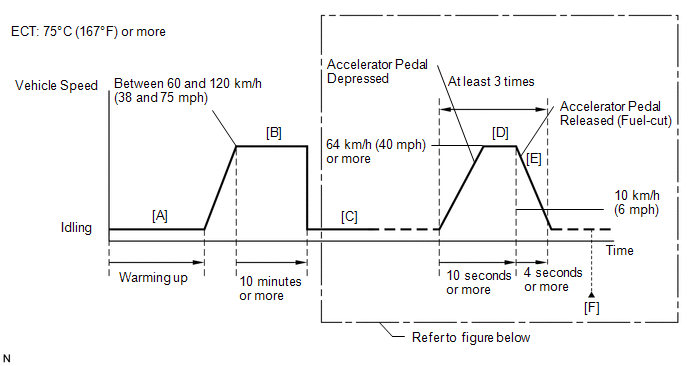
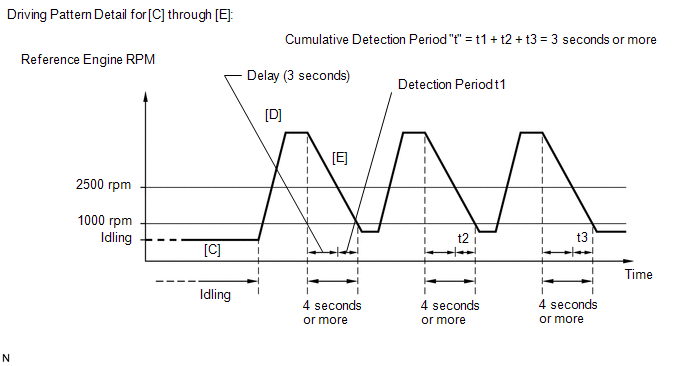
- Connect the Techstream to the DLC3.
- Turn the ignition switch to ON.
- Turn the Techstream on.
- Clear DTCs (even if no DTCs are stored, perform the clear DTC operation).
- Turn the ignition switch off and wait for at least 30 seconds.
- Turn the ignition switch to ON and turn the Techstream on.
- Start the engine, and warm it up until the ECT reaches 75°C (167°F) or higher [A].
- On the Techstream, enter the following menus to check the fuel-cut
status: Powertrain / Engine and ECT / Data List / Idle Fuel Cut.
- Drive the vehicle at between 60 and 120 km/h (38 and 75 mph) for at least 10 minutes [B].
CAUTION:
When performing the confirmation driving pattern, obey all speed limits and traffic laws.
- Shift the transmission to 2nd gear [C].
- Accelerate the vehicle to 64 km/h (40 mph) or more by depressing the accelerator pedal for at least 10 seconds [D].
CAUTION:
When performing the confirmation driving pattern, obey all speed limits and traffic laws.
- Soon after performing step [D] above, release the accelerator pedal for
at least 4 seconds without depressing the brake pedal in order to
execute fuel-cut control [E].
HINT:
Fuel-cut is performed when the following conditions are met:
- Accelerator pedal is fully released.
- Engine speed is 2500 rpm or more (fuel injection returns at 1000 rpm).
- Allow the vehicle to decelerate until the vehicle speed decreases to less than 10 km/h (6 mph).
- Repeat steps [C] through [E] above at least 3 times in one driving cycle.
- Enter the following menus: Powertrain / Engine and ECT / Trouble Codes [F].
- Read the pending DTCs.
HINT:
- If a pending DTC is output, the system is malfunctioning.
- If a pending DTC is not output, perform the following procedure.
- Enter the following menus: Powertrain / Engine and ECT / Utility / All Readiness.
- Input the DTC: P2195, P2196, P2197 or P2198.
- Check the DTC judgment result.
|
Techstream Display |
Description |
|
NORMAL |
- DTC judgment completed
- System normal
|
|
ABNORMAL |
- DTC judgment completed
- System abnormal
|
|
INCOMPLETE |
- DTC judgment not completed
- Perform driving pattern after confirming DTC enabling conditions
|
|
N/A |
- Unable to perform DTC judgment
- Number of DTCs which do not fulfill DTC preconditions has reached ECU memory limit
|
HINT:
- If the judgment result shows NORMAL, the system is normal.
- If the judgment result shows ABNORMAL, the system has a malfunction.
- If the judgment result shows INCOMPLETE or N/A, perform steps [B] through [F] again.
- If no pending DTC is output, perform a universal trip and check for permanent DTCs (See page
 ). ).
HINT:
- If a permanent DTC is output, the system is malfunctioning.
- If no permanent DTC is output, the system is normal.
WIRING DIAGRAM
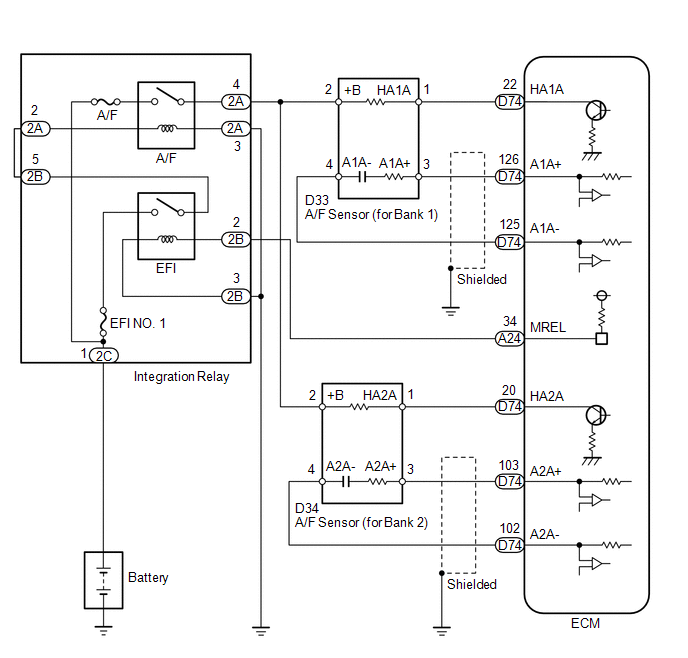 CAUTION / NOTICE / HINT
HINT:
PROCEDURE |
1. | CHECK ANY OTHER DTCS OUTPUT (IN ADDITION TO P2195, P2196, P2197 OR P2198) |
(a) Connect the Techstream to the DLC3. (b) Turn the ignition switch to ON.
(c) Turn the Techstream on. (d) Enter the following menus: Powertrain / Engine and ECT / Trouble Codes.
(e) Read DTCs. Result |
Result | Proceed to | |
P2195, P2196, P2197 or P2198 is output |
A | | "P2195, P2196, P2197 or P2198" and "P0136, P0137, P0138, P0156, P0157 or P0158" are output |
A | | P2195, P2196, P2197 or P2198 and other DTCs are output |
B | HINT: If
any DTCs relating to the A/F sensor (DTCs for the A/F sensor heater or
A/F sensor admittance) are output, troubleshoot those DTCs first.
| B |
 | GO TO DTC CHART |
|
A |
 | |
| 2. |
CONFIRM IF VEHICLE HAS RUN OUT OF FUEL IN PAST |
(a) Has the vehicle run out of fuel in the past?
| NO |
 | GO TO STEP 4 |
|
YES |
 | |
| 3. |
PERFORM CONFIRMATION DRIVING PATTERN | (a) Connect the Techstream to the DLC3.
(b) Turn the ignition switch to ON. (c) Turn the Techstream on.
(d) Clear the DTCs (See page  ). ). (e) Turn the ignition switch off.
(f) Turn the ignition switch to ON and turn the Techstream on. (g) Start the engine and warm it up.
(h) Drive the vehicle in accordance with the driving pattern described in the Confirmation Driving Pattern.
(i) Enter the following menus: Powertrain / Engine and ECT / Utility / All Readiness.
(j) Input the DTC: P2195, P2196, P2197 or P2198. (k) Check the DTC judgment result. Result |
Result | Proceed to | |
NORMAL (DTC is not output) |
A | | ABNORMAL
(DTC P2195, P2196, P2197 or P2198 is output) |
B |
| A |
 | DTC CAUSED BY RUNNING OUT OF FUEL |
|
NG |
 | |
| 4. |
READ VALUE USING TECHSTREAM (TEST VALUE OF A/F SENSOR) |
(a) Connect the Techstream to the DLC3. (b) Turn the ignition switch to ON.
(c) Turn the Techstream on. (d) Clear DTCs (See page
 ). ). (e) Drive the vehicle in accordance with the drive pattern described in the CONFIRMATION DRIVING PATTERN.
(f) Enter the following menus: Powertrain / Engine and ECT / Monitor / O2 Sensor.
(g)
Check that the status of O2 Sensor is Complete. If the status is still
Incomplete, drive the vehicle according to the driving pattern again. (h) Enter the following menus: Powertrain / Engine and ECT / Monitor / O2 Sensor / Details / RANGE B1S1 or RANGE B2S1.
(i) Check the test value of the A/F sensor output current during fuel-cut. Result |
Test Value | Proceed to | |
Within normal range (0.7 mA or more, and less than 2.2 mA) |
A | | Outside normal range (Less than 0.7 mA, or 2.2 mA or more) |
B |
| B |
 | GO TO STEP 16 |
|
A |
 | |
| 5. |
READ VALUE USING TECHSTREAM (OUTPUT VOLTAGE OF A/F SENSOR) |
(a) Connect the Techstream to the DLC3. (b) Start the engine. (c) Turn the Techstream on.
(d) Warm up the A/F sensor at an engine speed of 2500 rpm for 90 seconds.
(e) Enter the following menus: Powertrain / Engine and ECT / Active Test / Control the Injection Volume for A/F Sensor.
(f)
Monitor the output Voltages of the air fuel ratio and heated oxygen
sensors (AFS Voltage B1S1 and O2S B1S2 or AFS Voltage B2S1 and O2S B2S2)
displayed on the Techstream.
HINT:
- Change the fuel injection volume within the range of -12.5% to +12.5%.
- The air fuel ratio sensor has an output delay of a few seconds and the
heated oxygen sensor has a maximum output delay of approximately 20
seconds.
- If the sensor output voltage does not change (almost no reaction) while
performing the Active Test, the sensor may be malfunctioning.
Standard Voltage: |
Techstream Display (Sensor) |
Injection Volume | Status |
Voltage | |
AFS Voltage B1S1 or AFS Voltage B2S1 (Air fuel ratio) |
+12.5% | Rich |
Below 3.1 V | |
-12.5% | Lean |
Higher than 3.4 V | |
O2S B1S2 or O2S B2S2 (Heated oxygen sensor) |
+12.5% | Rich |
Higher than 0.55 V | |
-12.5% | Lean |
Below 0.4 V | Result |
Status of AFS Voltage B1S1 or AFS Voltage B2S1 |
Status of O2S B1S2 or O2S B2S2 |
Air Fuel Ratio Condition and Air fuel Ratio Sensor Condition |
Proceed to | | Lean |
Lean | Actual air fuel ratio lean |
A | | Rich |
Rich | Actual air fuel ratio rich |
A | | Lean |
Lean/Rich | Air fuel ratio sensor malfunction |
B | | Rich |
Lean/Rich | Air fuel ratio sensor malfunction |
B | | Lean/Rich |
Lean/Rich | Normal |
B | Lean:
During the Control the injection Volume for A/F Sensor Active Test, the
air fuel ratio sensor output voltage (AFS Voltage) is consistently
higher than 3.4 V, and the heated oxygen sensor output voltage (O2S) is
consistently below 0.4 V. Rich: During the
Control the injection Volume for A/F Sensor Active Test, the AFS Voltage
is consistently below 3.1 V, and the O2S is consistently higher than
0.55 V. Lean/Rich: During the Control the
injection Volume for A/F Sensor Active Test, the output voltage of the
heated oxygen sensor alternates correctly.
| B |
 | GO TO STEP 16 |
|
A |
 | |
(a) Check the intake system for vacuum leaks (See page
 ). ). OK: No leaks in intake system.
HINT: Perform "Inspection After Repair" after repairing or replacing the intake system (See page
 ). ).
| NG |  |
REPAIR OR REPLACE INTAKE SYSTEM |
|
OK |
 | |
| 7. |
CHECK FOR EXHAUST GAS LEAK | (a) Check for exhaust gas leak.
OK: No gas leak HINT: Perform "Inspection After Repair" after repairing or replacing the exhaust system (See page
 ). ).
| NG |  |
REPAIR OR REPLACE EXHAUST SYSTEM |
|
OK |
 | |
(a) Check the fuel pressure (See page
 ). ).
| NG |  |
GO TO STEP 18 |
|
OK |
 | |
| 9. |
INSPECT FUEL INJECTOR ASSEMBLY | (a) Check the fuel injector (whether fuel volume is high or low, and whether injector pattern is poor) (See page
 ). ). HINT: Perform "Inspection After Repair" after replacing the fuel injector assembly (See page
 ). ).
| NG |  |
REPLACE FUEL INJECTOR ASSEMBLY |
|
OK |
 | |
| 10. |
REPLACE AIR FUEL RATIO SENSOR | (a) Replace the air fuel ratio sensor (See page
 ). ). HINT: Perform "Inspection After Repair" after replacing the air fuel ratio sensor (See page
 ). ).
|
NEXT |
 | |
| 11. |
PERFORM CONFIRMATION DRIVING PATTERN | (a) Connect the Techstream to the DLC3.
(b) Turn the ignition switch to ON. (c) Turn the Techstream on.
(d) Clear the DTCs (See page  ). ). (e) Turn the ignition switch off and wait for at least 30 seconds.
(f) Turn the ignition switch to ON and turn the Techstream on. (g) Start the engine and warm it up.
(h) Drive the vehicle in accordance with the driving pattern described in the Confirmation Driving Pattern.
(i) Enter the following menus: Powertrain / Engine and ECT / Utility / All Readiness.
(j) Input the DTC: P2195, P2196, P2197 or P2198. (k) Check the DTC judgment result. Result |
Result | Proceed to | |
ABNORMAL (DTC P2195, P2196, P2197 or P2198 is output) |
A | | NORMAL
(DTC is not output) | B |
| B |
 | END |
|
A |
 | |
| 12. |
PERFORM ACTIVE TEST USING TECHSTREAM (CONTROL THE EGR STEP POSITION) |
(a) Connect the Techstream to the DLC3. (b) Start the engine and warm it up until the engine coolant temperature reaches 75°C (167°F) or higher.
HINT:
- When performing the Active Test, make sure the shift lever is in P or N.
- The A/C switch and all accessory switches should be off.
(c) Turn the Techstream on. (d) Enter the following menus: Powertrain / Engine and ECT / Active Test / Control the EGR Step Position.
(e)
Confirm the Throttle Idle Position is ON and check the engine idling
condition and MAP values in the Data List while performing the Active
Test.
HINT:
- Do not leave the EGR valve open for 10 seconds or more during the Active Test.
- Be sure to return the EGR valve to step 0 when the Active Test is completed.
OK: MAP and idling condition change in response to EGR step position as follows.
Standard: |
- | EGR Step Position (Active Test) | |
0 Steps | 0 to 30 Steps | |
Idling condition | Steady idling |
Idling changes from steady to rough idling or engine stall | |
MAP (Data List) |
20 to 40 kPa (150 to 300 mmHg) |
MAP value is at least +10 kPa (75 mmHg) higher than when EGR valve is fully closed |
| OK |
 | GO TO STEP 14 |
|
NG |
 | |
| 13. |
INSPECT EGR VALVE ASSEMBLY | (a) Remove the EGR valve assembly (See page
 ). ). (b) Check if the EGR valve is stuck open.
OK: EGR valve is tightly closed. HINT: Perform "Inspection After Repair" after repairing or replacing the EGR valve assembly (See page
 ). ).
| NG |  |
REPLACE EGR VALVE ASSEMBLY |
|
OK |
 | |
(a) Replace the ECM (See page
 ). ).
|
NEXT |
 | |
| 15. |
CONFIRM WHETHER MALFUNCTION HAS BEEN SUCCESSFULLY REPAIRED |
(a) Connect the Techstream to the DLC3. (b) Turn the ignition switch to ON.
(c) Turn the Techstream on. (d) Clear the DTC (See page
 ). ). (e) Turn the ignition switch off and wait for at least 30 seconds.
(f) Turn the ignition switch to ON and turn the Techstream on. (g) Start the engine and warm it up.
(h) Drive the vehicle in accordance with the driving pattern described in the Confirmation Driving Pattern.
(i) Enter the following menus: Powertrain / Engine and ECT / Utility / All Readiness.
(j) Input the DTC: P2195, P2196, P2197 or P2198. (k) Check the DTC judgment result. Result |
Techstream Display | Description | |
NORMAL |
- DTC judgment completed
- System normal
| | ABNORMAL |
- DTC judgment completed
- System abnormal
| | INCOMPLETE |
- DTC judgment not completed
- Perform driving pattern after confirming DTC enabling conditions
| | N/A |
- Unable to perform DTC judgment
- Number of DTCs which do not fulfill DTC preconditions has reached ECU memory limit
|
| NEXT |
 | END |
| 16. |
REPLACE AIR FUEL RATIO SENSOR | (a) Replace the air fuel ratio sensor (See page
 ). ). HINT: Perform "Inspection After Repair" after replacing the air fuel ratio sensor (See page
 ). ).
|
NEXT |
 | |
| 17. |
PERFORM CONFIRMATION DRIVING PATTERN | (a) Connect the Techstream to the DLC3.
(b) Turn the ignition switch to ON. (c) Turn the Techstream on.
(d) Clear the DTCs (See page  ). ). (e) Turn the ignition switch off and wait for at least 30 seconds.
(f) Turn the ignition switch to ON and turn the Techstream on. (g) Start the engine and warm it up.
(h) Drive the vehicle in accordance with the driving pattern described in the Confirmation Driving Pattern.
(i) Enter the following menus: Powertrain / Engine and ECT / Utility / All Readiness.
(j) Input the DTC: P2195, P2196, P2197 or P2198. (k) Check the DTC judgment result. Result |
Result | Proceed to | |
NORMAL (DTC is not output) |
A | | ABNORMAL
(DTC P2195, P2196, P2197 or P2198 is output) |
B |
| A |
 | END |
| B |
 | REPLACE ECM |
(a) Check the fuel lines for leaks or blockage.
HINT: Perform "Inspection After Repair" after replacing the fuel pump (See page
 ). ).
| OK |  |
REPLACE FUEL PUMP |
| NG |
 | REPAIR OR REPLACE FUEL LINE | | 



